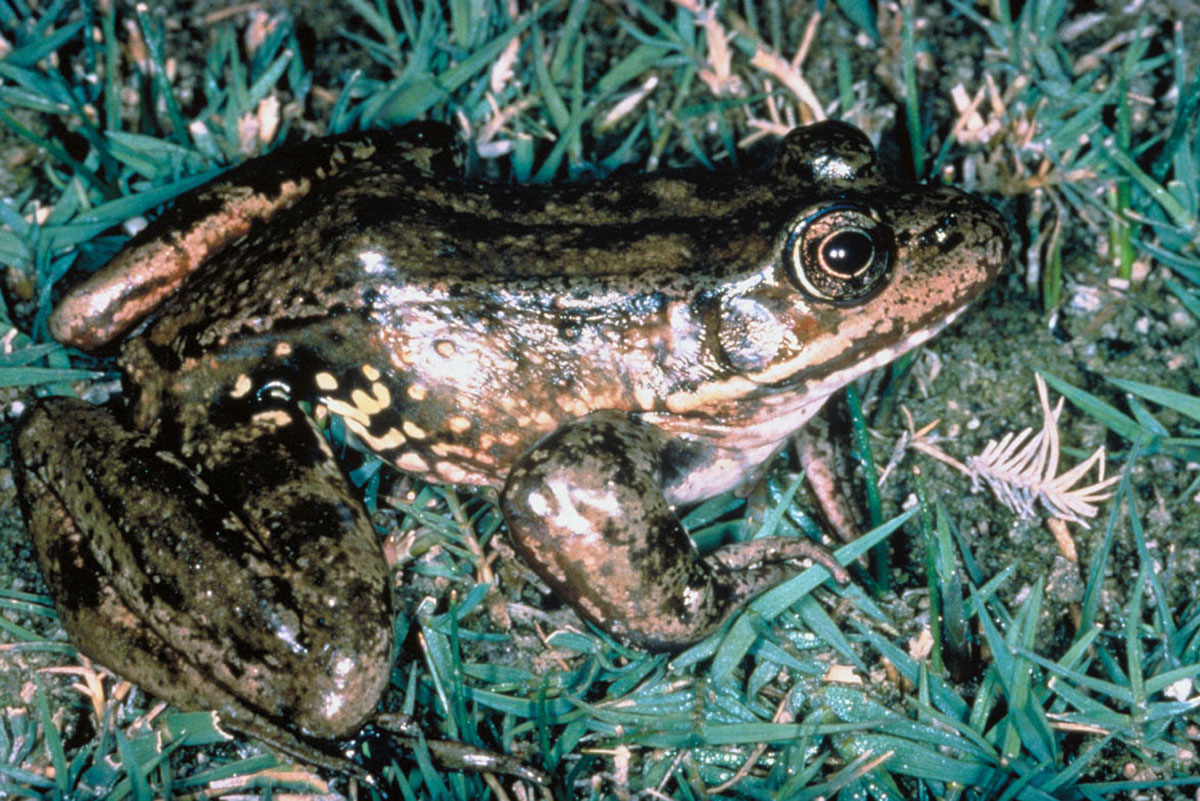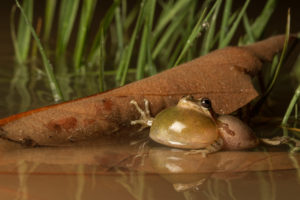here are three kinds of federally listed frogs in California, and they are simply endangered by modern life.
“Factors associated with declining populations of the frog,” says the U.S. Fish and Wildlife Service’s red-legged frog recovery plan, “include degradation and loss of its habitat through agriculture, urbanization, mining, overgrazing, recreation, timber harvesting, non-native plants, impoundments, water diversions, degraded water quality, use of pesticides, and introduced predators.”
Habitat destruction, spurred by a human need to dredge and dry out low-lying wetlands, is probably the biggest problem. Amphibians are found on every continent except Antarctica, but 90 percent of their habitat is gone, says Kathlyn Franco, a wetlands coordinator with Save the Frogs. Frogs need water to breed, so the many centuries people spent diverting water have exacted an enormous toll. In most places there is just no longer enough water to support healthy amphibian populations. “It’s pretty amazing how much water we’ve moved and gotten rid of,” Franco says. “We need to build wetlands everywhere, because they were everywhere.”
Save the Frogs is trying to change the status quo. In 2014, the group launched a wetland-building campaign it calls “Re-frogging America.” Kerry Kriger, the founder and executive director of Save the Frogs, says the goal is to add 1,000 wetlands in the United States in the next decade. Save the Frogs wants to build half of those wetlands, with caring citizens nationwide supplying the rest. (The group offers wetland construction workshops.)
The challenge is: where to build these wetlands? It’s one thing to identify moved water as the cause of amphibian decline, quite another to identify a place to move that water back. Kriger has identified more or less three options. One is to create wetlands in existing parks, such as the Eldorado National Forest, where Save the Frogs built six wetlands in 2014. Another option is to build wetlands on private land, with the permission of the landowner. (The Re-frogging America mailing list includes the question “Do you want a wetland?”)
In the Bay Area, the preferred option has turned out to be school property – convenient, and arguably a place where the wetlands will have the most educational influence on the people around them. Sometimes this is a relatively easy process, and sometimes a very hard one, but always it is an illustration of the challenges in attempting to improve conditions for wildlife in a human setting.
At San Lorenzo Valley Charter School in Ben Lomond in the Santa Cruz Mountains, for example, the school and nonprofit worked together easily to fill in a former pond. Administrators and students alike watched for rains to fill it in and for frogs to return.
At Manor Elementary School in Fairfax, bureaucratic roadblocks and administrative concerns about permit compliance and accessibility have stalled a similar project.
Working school district by school district (each with its own rules), figuring out local permits and presenting to school boards, not to mention constructing wetlands, means a significant effort for a small outfit like Save the Frogs. But, says U.S. Fish and Wildlife Service frog biologist Jane Hendron, “every bit helps.” Hendron told the story of the recovery of the mountain yellow-legged frog, which was down to 100 individuals before agencies and conservation groups worked together to start a captive breeding program and eventually wild reintroduction — a venture that saved the species.
“Gotta do it. Gotta go down fighting,” said California Fish and Wildlife biologist Chris Nagano. “Can’t just throw up your hands… [If you] think about the whole world it makes you crazy. Focus on one species or wetland.”
The federal recovery plan for the California red-legged frog set a target for delisting it in 2025 — also the 10-year mark for Save the Frogs’ plan to build 1,000 wetlands. Both are ambitious, but every project brings them closer.
Clifford School in Redwood City is one of the success stories. First-grade teacher Gwen Minor saw students smashing Pacific chorus frogs in a drainage ditch near the school a few years ago and proposed a wetland in place of the drainage ditch to help inspire and educate. The school board approved the project unanimously last May, and the wetlands were constructed this winter.
Teachers have taught kids at the side of the drainage ditch for 20 years, she said, but “now it can be a real classroom,” Minor said. “This is an amazing resource for the community.”
On the first day of construction, the former drainage ditch behind the field at Clifford School was swarming with students who were helping convert it into a wetland with six separate pools. Kriger observed the progress from the Frog Pond Observation Deck next to the ditch.
“The teachers are super happy about it,” he said. “We’ve had hundreds of kids out here today, and they went straight to the shovels.”
In the thick of what will soon be wetlands, wetland construction expert Tom Biebighauser stood in the center of a group of students, explaining the concept of “slope” as they dug the wetlands and spread the dirt on the hillside behind
For many of the kids, it is the “first time they’ve used shovels or rakes,” Biebighauser said. “Today we’ve taught them about slope and aquatic plants.” Mosquitoes will probably move in, Biebighauser said – but as the bottom of a food web that will also include salamanders, frogs, toads, water striders, dragonflies, and damselflies. Bringing a wetland back includes the whole picture, healthy ecosystem and all.
Clifford School is situated on what was once a much larger wetland, Biebighauser said. The scene was a reminder of the way people have moved water around, to the detriment of frogs – and the way some people are now moving it back to the frogs’ benefit. Biebighauser directed me to a hill behind the field and asked what I thought the landscape looked like before the school was built. The flat top of the hill meant it had been cut off to supply dirt to something else — “and where do you think they put that dirt?”
Biebighauser’s face brightened as I slowly made the connection: that hill had filled in this wetland. Water out, frogs out except for the drainage ditch where the amphibians remained, waiting.





